American film actor Richard Dix (1893–1949) achieved popularity in both silent and sound films, first as the rugged and stalwart hero in countless Westerns, then in dramatic features such as Cecil B. DeMille's The Ten Commandments (1923). After his years of silent film at Paramount, and thanks to his deep voice and commanding presence, he became a well-known star at RKO in the 1930s. He was nominated for the Academy Award for Best Actor for his lead role in the Best Picture-winning epic, Cimarron (1931).

Vintage photo. Signature: Sincerely Richard Dix.

French postcard by Editions Cinémagazine, no. 220.
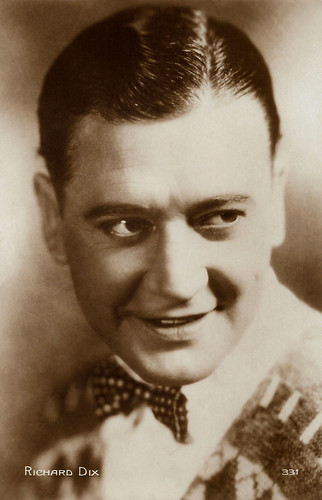
French postcard by Cinémagazine-Edition, Paris, no. 331.
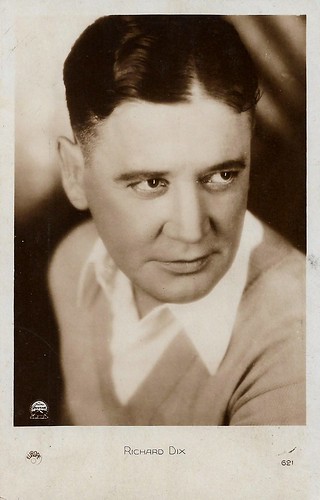
French postcard by Europe, no. 21.
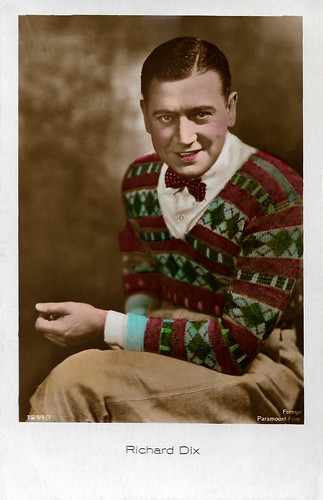
German postcard by Ross Verlag, Foreign, no. 1244/1, 1927-1928. Photo: Paramount.
Richard Dix was born Ernest Carlton Brimmer in 1893, in St. Paul, Minnesota. There he was educated, and at the desire of his father, studied to be a surgeon. His obvious acting talent in his school dramatic club led him to lead roles in most of the school plays. Dix excelled in sports, especially football and baseball. These skills would serve him well in the vigorous film roles he would go on to play.
After a year at the University of Minnesota, he took a position at a bank, spending his evenings training for the stage. His professional start was with a local stock company, and this led to similar work in New York.
The death of his father left him with a mother and sister to support. He went to Los Angeles and changed his name to Dix. He became a leading man for the Morosco Stock Company and his success there got him a contract with Paramount Pictures. His rugged good looks and dark features made him a popular player in Westerns.
Dix's best-remembered early role was in Cecil B. DeMille's silent version of the religious epic film The Ten Commandments (1923). Lauded for its immense and stupendous scenes, use of the Technicolor process, and the parting of the Red Sea sequence, the expensive film proved to be a box-office hit upon release.
His athletic ability led to his starring role opposite Jean Arthur in Paramount's Warming Up (Fred C. Newmeyer, 1928), a baseball story, and also the studio's first feature with synchronised score and sound effects. His deep voice and commanding presence were perfectly suited for the talkies, and he was signed by RKO Radio Pictures in 1929.
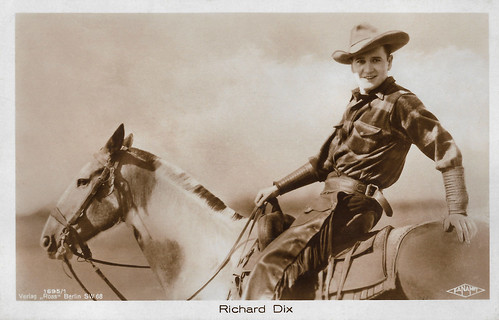
German postcard by Ross Verlag, no. 1685/1, 1927-1928. Photo: Fanamet. Richard Dix in Womanhandled (Gregory La Cava, 1925).

German postcard by Ross Verlag, no. 1880/1, 1927-1928. Photo: Paramount / Fanamet.

German postcard by Ross Verlag, no. 875/2, 1925-1926. Photo: Paramount.

German postcard by Ross Verlag, no. 2027/1, 1927-1928. Photo: Paramount / Fanamet. Richard Dix in Moran of the Marines (Frank R. Strayer, 1928).

German postcard by Ross Verlag, no. 3206/1, 1928-1929. Photo: Parufamet / Paramount. Richard Dix in The Wheel of Life (Victor Schertzinger, 1929).
Richard Dix was a major leading man at RKO Radio Pictures from 1929 through 1943. Dix scored an early triumph in the all-talking mystery drama, Seven Keys to Baldpate (Reginald Barker, 1929) with Margaret Livingston. In 1931 he was nominated for a Best Actor Oscar for his masterful performance in Cimarron (Wesley Ruggles, 1931) opposite Irene Dunne. Cimarron, based on the popular novel by Edna Ferber, took the Best Picture award. Epic in scope, spanning forty years from 1889 to 1929, it was a critical success, although it did not recoup its production costs during its initial run in 1931.
Throughout the 1930s Dix would be a big box-office draw at RKO, appearing in mystery thrillers, potboilers, Westerns, and programmers. A memorable role for Dix was in the British futuristic film The Tunnel (Maurice Elvey, 1935) opposite Leslie Banks. The film, produced at a time when the threat of war loomed in Europe, emphasised international cooperation between the United States and the United Kingdom.
In 1941, Dix played Wild Bill Hickok in the Western Badlands of Dakota (Alfred E. Green, 1941) opposite Robert Stack, and portrayed former gunslinger Wyatt Earp the following year in another Western, Tombstone, the Town Too Tough to Die (William C. McGann, 1942), featuring Edgar Buchanan as Curly Bill Brocious. Dix also starred as the homicidal Captain Stone in the Val Lewton production of The Ghost Ship (Mark Robson, 1943).
In 1944, Dix starred in the mystery Film Noir The Whistler (William Castle, 1944), co-starring Gloria Stuart and J. Carrol Naish. Based on the radio drama 'The Whistler', it was the first of Columbia Pictures' eight 'Whistler' films in which Dix played a different character each time. (He did not play the 'Whistler', who was an unseen narrator.) By the time Dix started the series, he was a heavy drinker and subject to hiccups. He retired from films in 1947.
He first married Winifred Coe in 1931. They had a daughter, Martha Mary Ellen, and then divorced in 1933. He then married Virginia Webster in 1934. They had twin boys, Richard Jr. and Robert Dix and an adopted daughter, Sara Sue. After years of fighting alcoholism, Richard Dix suffered a serious heart attack in 1949, while on a train from New York to Los Angeles. He died a week later in Los Angeles at the age of 56. Dix was interred at Forest Lawn (Glendale), Glendale, California, in the Whispering Pines section, lot #2387. Dix has a star on the Hollywood Walk of Fame in the Motion Pictures section at 1610 Vine Street. It was dedicated in 1960.

German postcard by Ross Verlag, no. 3386/1, 1928-1929. Photo: Paramount.

German postcard by Ross Verlag, no. 3502/1, 1928-1929. Photo: Paramount. Richard Dix in The Gay Defender (Gregory La Cava, 1927).
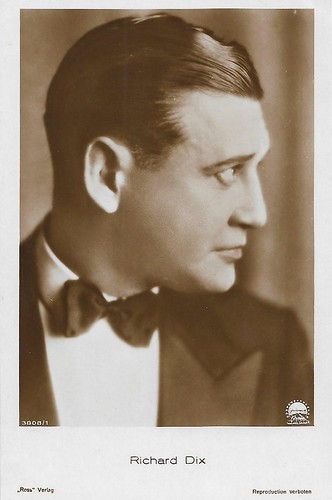
German postcard by Ross Verlag, no. 3808/1, 1928-1929. Photo: Paramount.
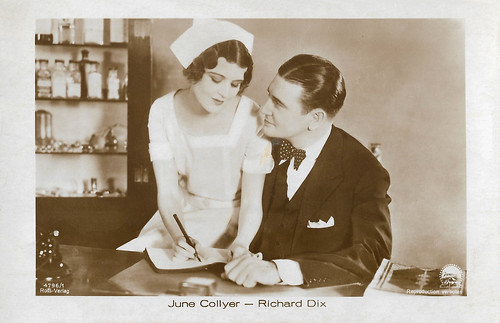
German postcard by Ross Verlag, no. 4796/1, 1929-1930. Photo: Paramount. June Collyer and Richard Dix in The Love Doctor (Melville W. Brown, 1929).

German postcard by Ross Verlag, no. 4979/1, 1929-1930. Photo: Paramount. Card mailed in Rotterdam, 1931.

Italian postcard by Cinema-Illustrazione, series 2, no. 32. Photo: United Artists. Richard Dix and Mary Lawlor in Shooting Straight (George Archainbaud, 1930).

German postcard by Ross Verlag, no. 6494/1, 1931-1932. Photo: Radio Film. Richard Dix in Cimarron (Wesley Ruggles, 1931).

Austrian postcard by Iris Verlag, no. 5299. Photo: Paramount.
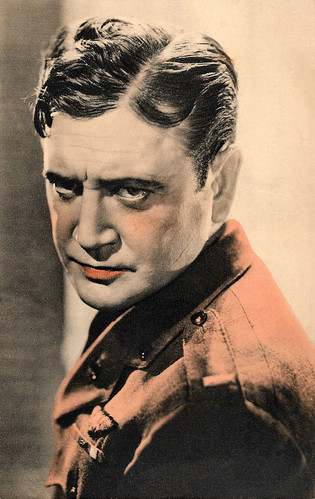
British postcard in the Film Picture Stories Star Series, no. 4. Photo: Radio Pictures.

British postcard in the Picturegoer Series, London, no. 1343. Photo: RKO Radio Pictures.
Sources: Richard Unger (IMDb), Wikipedia, and IMDb.
Last updated on 14 January 2024.

Vintage photo. Signature: Sincerely Richard Dix.

French postcard by Editions Cinémagazine, no. 220.

French postcard by Cinémagazine-Edition, Paris, no. 331.

French postcard by Europe, no. 21.

German postcard by Ross Verlag, Foreign, no. 1244/1, 1927-1928. Photo: Paramount.
Rugged good looks and dark features
Richard Dix was born Ernest Carlton Brimmer in 1893, in St. Paul, Minnesota. There he was educated, and at the desire of his father, studied to be a surgeon. His obvious acting talent in his school dramatic club led him to lead roles in most of the school plays. Dix excelled in sports, especially football and baseball. These skills would serve him well in the vigorous film roles he would go on to play.
After a year at the University of Minnesota, he took a position at a bank, spending his evenings training for the stage. His professional start was with a local stock company, and this led to similar work in New York.
The death of his father left him with a mother and sister to support. He went to Los Angeles and changed his name to Dix. He became a leading man for the Morosco Stock Company and his success there got him a contract with Paramount Pictures. His rugged good looks and dark features made him a popular player in Westerns.
Dix's best-remembered early role was in Cecil B. DeMille's silent version of the religious epic film The Ten Commandments (1923). Lauded for its immense and stupendous scenes, use of the Technicolor process, and the parting of the Red Sea sequence, the expensive film proved to be a box-office hit upon release.
His athletic ability led to his starring role opposite Jean Arthur in Paramount's Warming Up (Fred C. Newmeyer, 1928), a baseball story, and also the studio's first feature with synchronised score and sound effects. His deep voice and commanding presence were perfectly suited for the talkies, and he was signed by RKO Radio Pictures in 1929.

German postcard by Ross Verlag, no. 1685/1, 1927-1928. Photo: Fanamet. Richard Dix in Womanhandled (Gregory La Cava, 1925).

German postcard by Ross Verlag, no. 1880/1, 1927-1928. Photo: Paramount / Fanamet.

German postcard by Ross Verlag, no. 875/2, 1925-1926. Photo: Paramount.

German postcard by Ross Verlag, no. 2027/1, 1927-1928. Photo: Paramount / Fanamet. Richard Dix in Moran of the Marines (Frank R. Strayer, 1928).

German postcard by Ross Verlag, no. 3206/1, 1928-1929. Photo: Parufamet / Paramount. Richard Dix in The Wheel of Life (Victor Schertzinger, 1929).
A big box-office draw at RKO
Richard Dix was a major leading man at RKO Radio Pictures from 1929 through 1943. Dix scored an early triumph in the all-talking mystery drama, Seven Keys to Baldpate (Reginald Barker, 1929) with Margaret Livingston. In 1931 he was nominated for a Best Actor Oscar for his masterful performance in Cimarron (Wesley Ruggles, 1931) opposite Irene Dunne. Cimarron, based on the popular novel by Edna Ferber, took the Best Picture award. Epic in scope, spanning forty years from 1889 to 1929, it was a critical success, although it did not recoup its production costs during its initial run in 1931.
Throughout the 1930s Dix would be a big box-office draw at RKO, appearing in mystery thrillers, potboilers, Westerns, and programmers. A memorable role for Dix was in the British futuristic film The Tunnel (Maurice Elvey, 1935) opposite Leslie Banks. The film, produced at a time when the threat of war loomed in Europe, emphasised international cooperation between the United States and the United Kingdom.
In 1941, Dix played Wild Bill Hickok in the Western Badlands of Dakota (Alfred E. Green, 1941) opposite Robert Stack, and portrayed former gunslinger Wyatt Earp the following year in another Western, Tombstone, the Town Too Tough to Die (William C. McGann, 1942), featuring Edgar Buchanan as Curly Bill Brocious. Dix also starred as the homicidal Captain Stone in the Val Lewton production of The Ghost Ship (Mark Robson, 1943).
In 1944, Dix starred in the mystery Film Noir The Whistler (William Castle, 1944), co-starring Gloria Stuart and J. Carrol Naish. Based on the radio drama 'The Whistler', it was the first of Columbia Pictures' eight 'Whistler' films in which Dix played a different character each time. (He did not play the 'Whistler', who was an unseen narrator.) By the time Dix started the series, he was a heavy drinker and subject to hiccups. He retired from films in 1947.
He first married Winifred Coe in 1931. They had a daughter, Martha Mary Ellen, and then divorced in 1933. He then married Virginia Webster in 1934. They had twin boys, Richard Jr. and Robert Dix and an adopted daughter, Sara Sue. After years of fighting alcoholism, Richard Dix suffered a serious heart attack in 1949, while on a train from New York to Los Angeles. He died a week later in Los Angeles at the age of 56. Dix was interred at Forest Lawn (Glendale), Glendale, California, in the Whispering Pines section, lot #2387. Dix has a star on the Hollywood Walk of Fame in the Motion Pictures section at 1610 Vine Street. It was dedicated in 1960.

German postcard by Ross Verlag, no. 3386/1, 1928-1929. Photo: Paramount.

German postcard by Ross Verlag, no. 3502/1, 1928-1929. Photo: Paramount. Richard Dix in The Gay Defender (Gregory La Cava, 1927).

German postcard by Ross Verlag, no. 3808/1, 1928-1929. Photo: Paramount.

German postcard by Ross Verlag, no. 4796/1, 1929-1930. Photo: Paramount. June Collyer and Richard Dix in The Love Doctor (Melville W. Brown, 1929).

German postcard by Ross Verlag, no. 4979/1, 1929-1930. Photo: Paramount. Card mailed in Rotterdam, 1931.

Italian postcard by Cinema-Illustrazione, series 2, no. 32. Photo: United Artists. Richard Dix and Mary Lawlor in Shooting Straight (George Archainbaud, 1930).

German postcard by Ross Verlag, no. 6494/1, 1931-1932. Photo: Radio Film. Richard Dix in Cimarron (Wesley Ruggles, 1931).

Austrian postcard by Iris Verlag, no. 5299. Photo: Paramount.

British postcard in the Film Picture Stories Star Series, no. 4. Photo: Radio Pictures.

British postcard in the Picturegoer Series, London, no. 1343. Photo: RKO Radio Pictures.
Sources: Richard Unger (IMDb), Wikipedia, and IMDb.
Last updated on 14 January 2024.
No comments:
Post a Comment